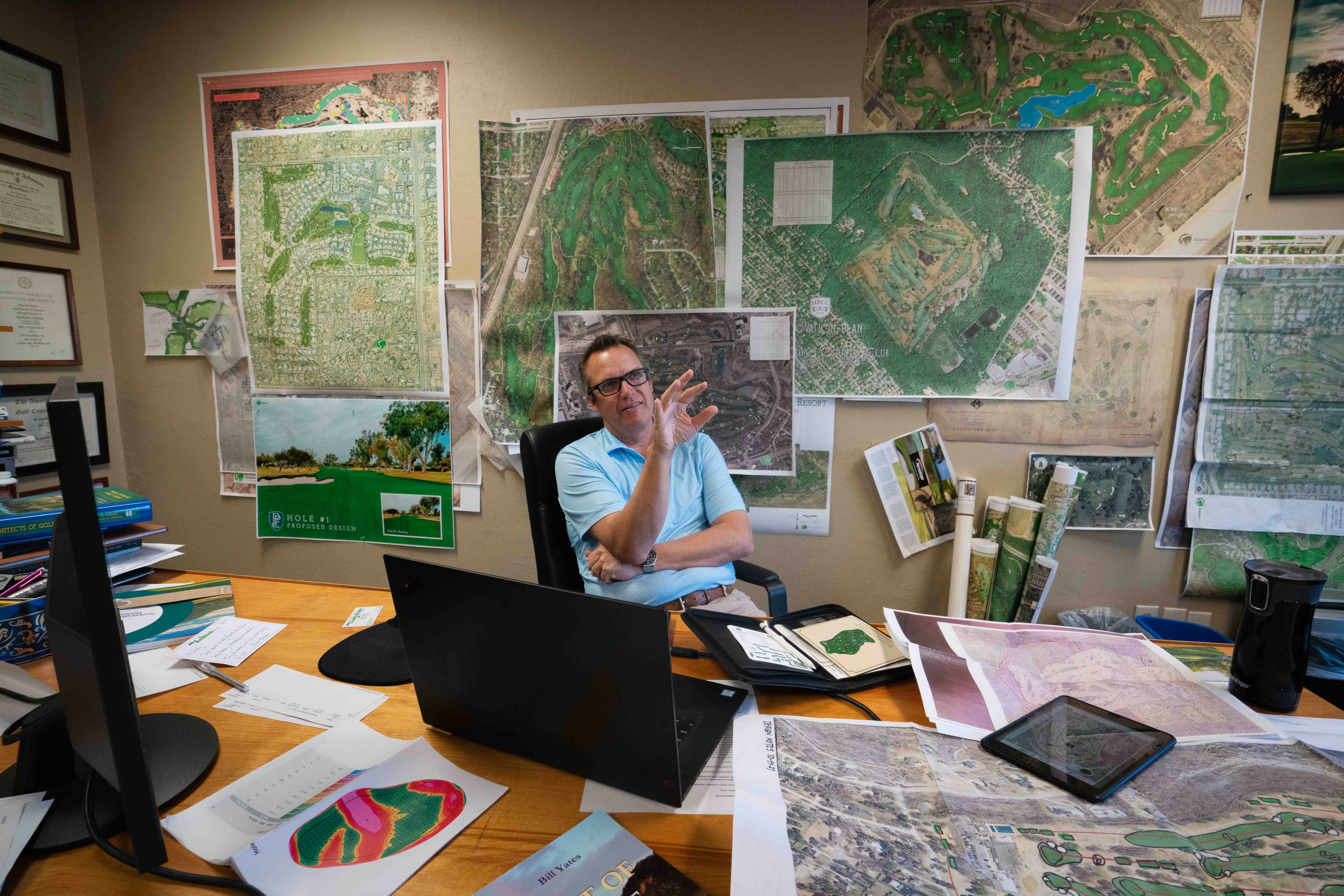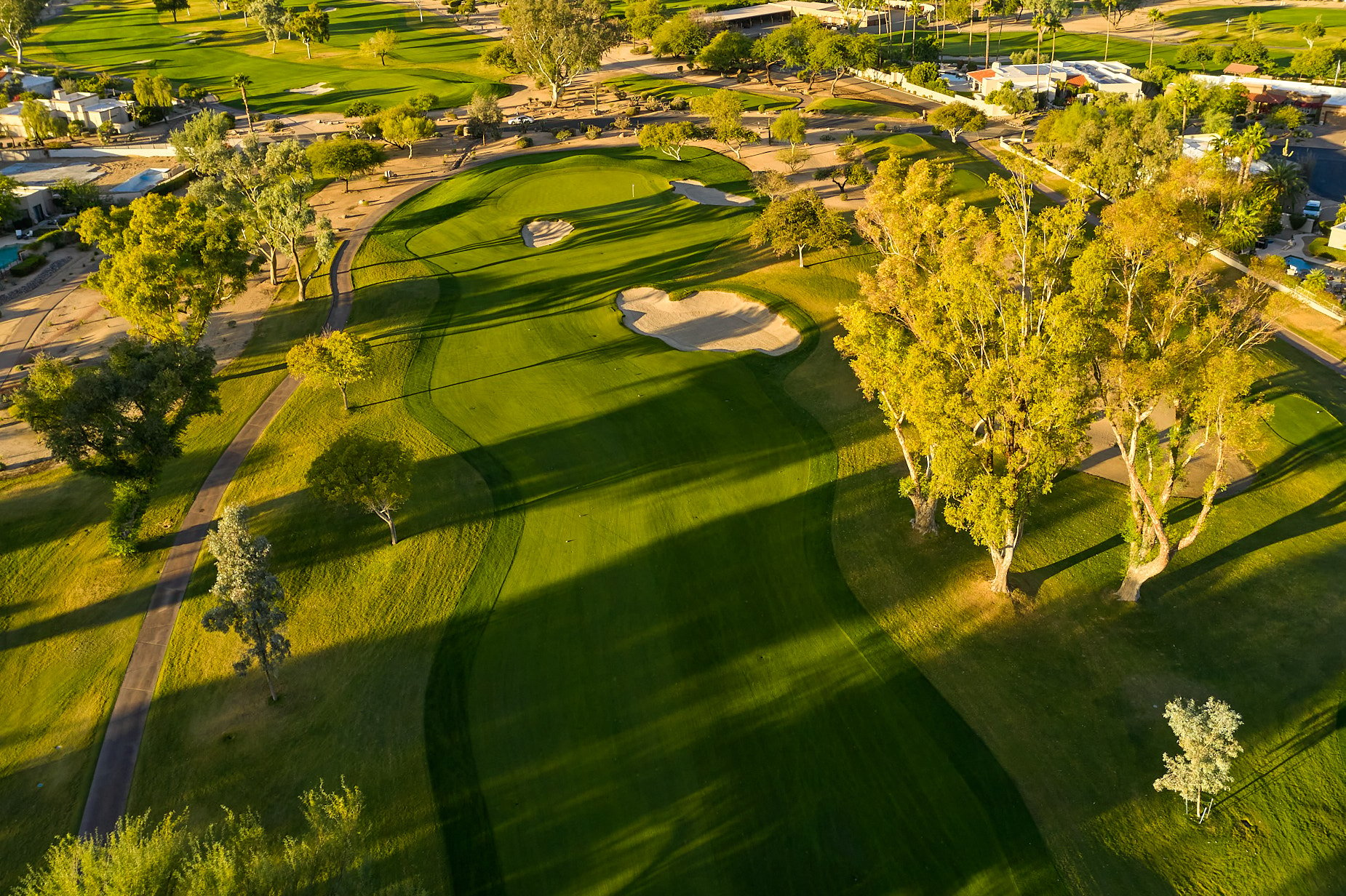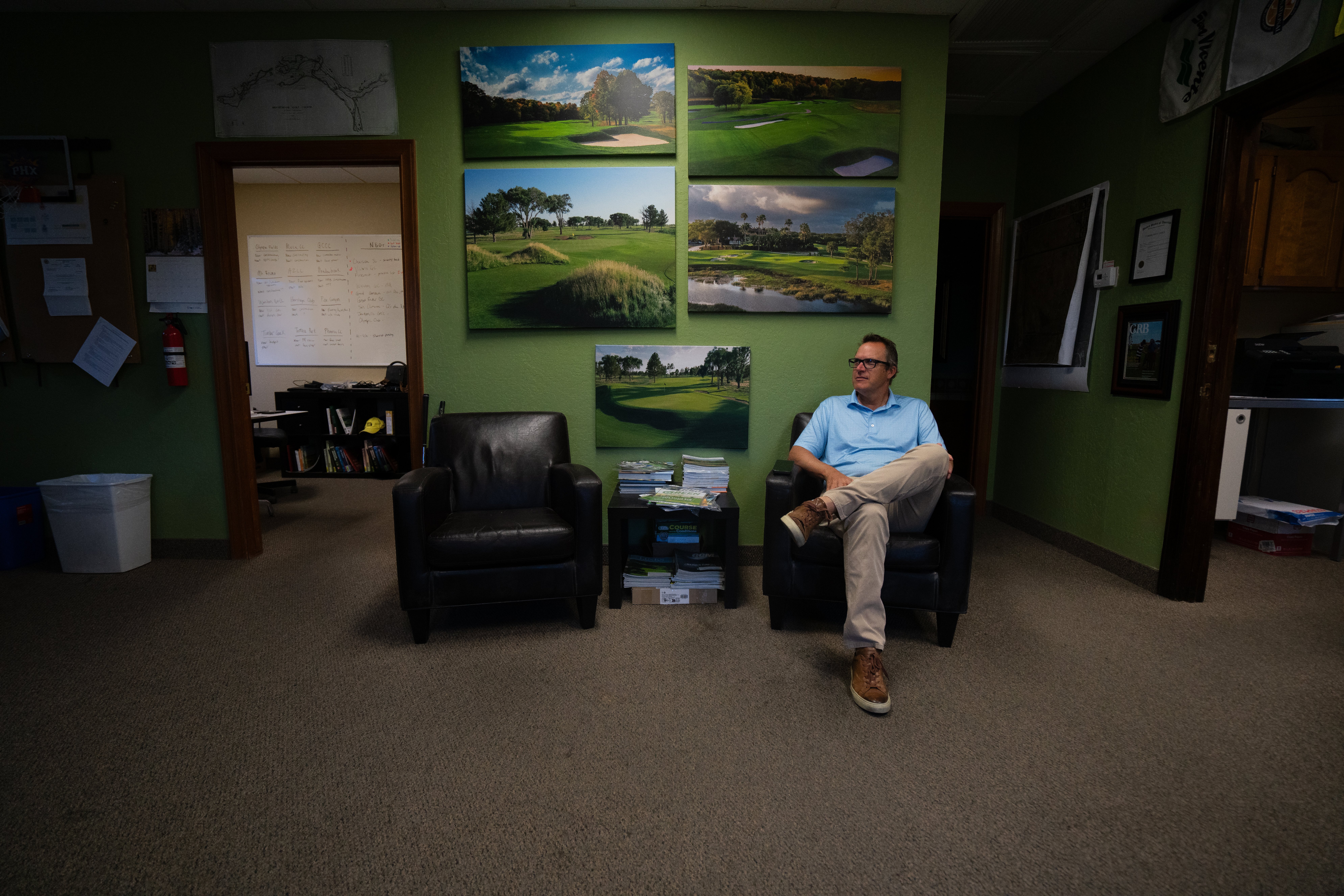
Architect Andy Staples fuses Golden Age principles and fresh ideas for golf course designs that are pure fun
Don’t call Andy Staples an overnight sensation. After all, the Scottsdale-based golf course architect has logged hours on job sites and drafting tables since the mid-1990s. He planned and co-designed Utah’s Sand Hollow, a Top 100 Modern course, in 2008. However, it’s a fistful of award-winning projects in the past eight years that has catapulted Staples to elite status in design circles. Within Arizona and beyond, Staples Golf Design is now invariably on the short list when clubs are contemplating a new or improved golf course.
 Hole #2 at Pinnacle Peak Country Club
Hole #2 at Pinnacle Peak Country Club
In the Valley, Staples has renovated features at FireRock Country Club in Fountain Hills and at Pinnacle Peak Country Club in Scottsdale during the past five years. He is currently revising Mesa Country Club, and has earned a master plan commission for Phoenix Country Club. He also consults at Arizona Country Club, where he is a member.
In the past decade, he has spearheaded new builds and refurbishments at public, private and resort courses in ten states, as well as lending his talents to one of Canada’s most prestigious clubs, Mount Bruno in Quebec. Staples is in such demand that in the past 24 months, he’s transitioned from a self-described “one-man band” to a present staff of four. Josh Goeden, Joey Chase and Tim Cloninger form the team, along with recent addition Abby Schmidt, a low-handicap intern by way of Arizona State University and Mesa Community College.
While Staples wasn’t born until 1972, the winds of 1920s Golden Age architecture blow through him constantly and permeate every project. Yet, he’s most renowned for his original ideas on sustainability and inclusiveness. In 2022, leading trade publication Golf Inc. magazine voted Staples one of the “9 Most Innovative People in Golf,” citing his “Community Links” idea for transforming a tired municipal course in Hobbs, New Mexico as “compelling and trailblazing.”
Though life on the road is inevitable for a busy architect, Staples is a family man at heart, and relishes his time at home with Ashley, his wife of 19 years, and sons Will (15), Luke (13) and John (9). None of his kids have drawn up any golf holes yet, but Luke is “really serious about playing golf,” according to his dad, so perhaps there’s a sketch or two on the horizon.
The Milwaukee native still roots hard for his Packers, Brewers and Bucks, but nearly two decades in Arizona have yielded a soft spot for the local teams, with a nod to the Diamondbacks’ remarkable run in 2023. We caught up with Staples recently at his Mesa Country Club renovation project and again by phone while he was on-site at a Cincinnati course renovation. We chatted about a variety of topics, including the most influential golf hole he encountered as a kid, how Golden Age design colors his thinking, and how he reimagined a golf course to also attract non-golfers.

How did you get involved with golf?
My dad, Jim Staples, brought me to the game when I was 7. He was a member at West Bend Country Club, which was the original Langford/Moreau front nine. I really was overcome by the game. I played baseball, basketball and football, but I focused on golf. I started practicing as often as I could, including the times I went up to the cottage we had on Lake Camelot in central Wisconsin. The lake had a pure sand beach, perfect for practicing my sand shots.
How did those early experiences evolve into golf course design?
Those practice shots turned to playing to one point on a little slope, which then turned into a flat rudimentary sand green, and nine small areas used as tees. My course was nine short holes of less than 25 yards. I worked on my course every weekend. I transplanted pine trees and even had an island tee box from the dock. One day my dad asked me if I knew that people design golf courses for a living. I was around 12 at the time, and was blown away. I liked to build stuff and I also loved to draw. I knew at that moment what I wanted to do with my life.
What stepping stones led you from a tiny course on a lakeshore to a full-time practicing architect?
I kept playing golf and tried to play collegiately [at the University of Arkansas]. But I realized I had a better chance of drawing pictures of golf courses than playing them. I studied landscape architecture, worked for Wadsworth [a leading golf course construction company], and got my degree. As a kid you don’t really know what it takes. I quickly learned that it was a difficult business to get into. You had to know the right people. I kind of busted in through the golf construction world and I guess the rest is history.
Staples joined Tulsa, Oklahoma-based Jerry Slack and Associates in 1995, and moved to Graves & Pascuzzo the California Bay Area in 1997 before hanging his own shingle in 2003. He relocated to Phoenix in 2004.
Which golf course influenced you most early in your career?
I have to go all the way back to West Bend Country Club. Anyone who has seen the front nine there realizes it gets a little steep and aggressive in some areas, but the natural routing of the layout combined with the strong engineered fill pad greens and features, such as the grass-faced bunkers – it was really impactful. At West Bend we learned to play on the first three holes. The third hole had one of these Langford design features off to the right-hand side off the tee, about 160 yards out, which is exactly where a young kid would hit it every single time. You didn’t want to go anywhere close to it, but you sliced it over there because you weren’t very good at golf. I remember trying to hit a 9-iron out of that thing and I would keep hitting up the slope and it would fall back down. I remember feeling the joy of actually getting it out of this feature, not once ever thinking that it was a very penal feature. I just assumed that I was not very good at golf.
And as I look back now, I think that the design had an incredible impact on just understanding why we love the game so much - that there’s this balance between enjoyment and challenge. We always want to get better.
In his approach to design and re-design, Staples adheres to the time-tested philosophy of Golden Age architects. Underrated greats of the era William Langford and Theodore Moreau were highly influential, as was Perry Maxwell, architect of Oklahoma’s Southern Dunes and Kansas’ Prairie Dunes. Architecture scholars have defined the Golden Age of Design as 1911 through 1937, with the highest concentration of truly great courses built in the 1920s. An enlightenment of sorts elevated elite courses designed during the Golden Age period, explained by historian Geoff Shackelford as a time “where early layouts were transformed from mundane and geometrically edged mediocrities to grand-scaled, artistic and strategically designed masterpieces.” Superior Golden Age courses eschewed artificiality. Architects typically employed a light touch on the landscape, preferring to let the site’s natural attributes shine.
 Hole #1 at Pinnacle Peak Country Club
Hole #1 at Pinnacle Peak Country Club
Why do Golden Age concepts and practices influence so much of what you do? In what ways are they visible in your work?
When you talk about the old courses, the Golden Age of Golf Course Architecture, there are things present that you like but you don’t know why, you just like it. It usually starts with a thoughtful and natural routing, where the flow and connectivity let you walk comfortably from a green to the next tee. It’s also the subtle land movements. Where I really focus the Golden Age aspects, though, is in the putting greens. That’s one big difference between Golden Age golf versus the modern age. At a project I’m working on now, you see the modern approach - artificial use of containment, catcher’s mitt mounds surrounding the greens, a focus on easy-to-maintain bunkering and slopes. Golden Age greens typically utilize a simple fill pad, where the emphasis is on the putting surface itself, not on the mounds, with the bunkers and other hazards built into the pads. I’m especially proud of what I accomplished at Meadowbrook Country Club in Detroit. [Using concepts consistent with the architectural style of Meadowbrook’s original designer, Willie Park Jr., from 1916, Staples constructed fill pad-style greens with very minimal mounding, fescue-fringed grassy hollows without sand, and Old World drainage ditches as strategic hazards. Meadowbrook was honored as a “Renovation of the Year” in 2017.] That project launched me into a different level of notoriety.
Long before sustainability and accessibility became major buzz words, Staples featured them front and center in his design practices. In recognizing Staples as one of the top 9 Innovators in Golf for 2022, Golf Inc. Magazine singled out his efforts at Rockwind Community Links in Hobbs, New Mexico:
“Alongside two new courses for players of all skill levels—a regulation-length 18-hole track and a nine-hole short course—he added an events center, miles of hiking trails, a lake and a picnic area. To save money, he maximized the facility’s use of fuel, water, electricity, fertilizers and chemicals, and to draw local traffic, he helped establish a First Tee program at the site.
“In short, Staples created a facility that can be used by the entire community, not just the small slice of people who play golf. The USGA called Rockwind ‘a blueprint for other communities,’ and the American Society of Golf Course Architects gave it a Design Excellence Award.”
Your concept for “Community Links” proved immensely successful and earned you many awards. What is “Community Links,” and could it work in Arizona?
Community Links is a paradigm shift for how community leaders should view their golf course, which uses the game of golf as a nexus for healthy living, community pride, and raising our youth. Further, “CL” emphasizes uses for both golfers and non-golfers, which is vitally important today when getting support for investments into failing facilities. Community Links was born with the idea of how do we actually use golf to benefit the conversation and to change people’s minds about the value of golf and not make it so much about water use, chemical use, and an exclusive game for rich guys. That’s the essence of Community Links, to show everybody who doesn’t play golf that there really is a lot of value in a golf course, and it really can be used in ways that aren’t just golf. I think every municipal course in the country has the ability to do this.
In 2021, Staples completed two courses for the PGA National Resort and Spa in Palm Beach Gardens, Florida. The property was previously home to five courses, including The Champion, a PGA Tour venue and site of the 1983 Ryder Cup and 1987 PGA Championship. Staples replaced The Squire, a 1983 George and Tom Fazio design with two courses, The Match and The Staple.
You picked up lots more hardware for what you achieved in transforming the Squire course at PGA National. What did you accomplish there?
I was competing against a lot of top architects who had been working in that market. I explored this idea that we could take one 18-hole course and make two courses out of it and address the pace of play and difficulty issues that made the old Squire course the least played layout and the most complained about. The Match is 18 holes, 5,744 yards. It’s designed around match play, not stroke play. It’s perhaps the only course in Florida that’s not rated, because you don’t post a score. It was designed to have a match, not to beat the course. There are no set tee markers during a round. The winner of the previous hole chooses where to play from next. The grass is cut short throughout, emphasizing the ground game and we minimized hazards. Our concept was to design 18 holes where maximizing playability for all skill levels, fostering a faster pace of play, as well as creating a unique golf experience where having nothing but fun was paramount. With the land left over, we created The Staple, a nine-hole short course. Every course the resort had was difficult. The Staple bridged the gap between golfers and non-golfers, a place for beginners and for time-challenged golfers to play. It’s perfect for families. It’s fun, social, wide open, but every green is interesting enough to make it enjoyable for low handicaps.
You’re now the go-to guy for the Valley’s private parkland layouts. What do you have planned for Mesa Country Club’s renovations?
Mesa Country Club was built in 1948 by William P. Bell, the Golden Age architect. We think it was one of the first courses William P. Bell and his son William F. Bell designed together. We’re not really thought of as being a historic state for great old classic golf courses, which is one of the reasons I was hired - because I have those tendencies. The big news item here is the water conservation work in relation to the irrigation system upgrade, the lake reduction plan, and the low water use in out of play areas. This will address the water issues and the upcoming state mandates. The redesign will take the course from 124 acres of turf that we water to something around 100 acres, with the ultimate goal of 90. Saving water is a core value of sustainable golf design. I try to do all my courses in such a manner that is looking 20, 30, 40 years down the line. Water efficiency, labor efficiency - those costs are only going up. So water is a huge aspect.
In addition to the water management and turf reduction, Staples will direct rebuilding the greens to USGA specs, restoring green sizes, creating new greens at holes 4 and 5, upgrading the putting surface grass to TifEagle Bermuda, and rebuilding the greenside bunkers. The course will close in February 2024 and reopen in November 2024.
You seem bullish on golf’s future and how architecture can contribute to its growth. How so?
Great architecture gives a golfer a feeling of enthusiasm for the game, making them want to play more. In that sense, we golf architects help grow the game. I also feel the game is uniquely positioned to capture the portion of our population that is looking for outdoor recreation, healthy activity, and spirited competition. It just needs to be presented in a way that is more accessible and easier for people to get into, with the intention that they become a lifelong participant. It’s a game that can be played well into your 80s, so it will always be there when you need it. We as golf architects just need to keep providing the playing fields that people want to use, provide them in a manner that gives us a bit of flexibility in how they’re accessed, and then ensure they are built sustainably, which allows our clients to make good returns on their investments.
What kind of legacy would you like to leave as an architect?
One of my influences is Bill Coore [one of golf’s top modern architects and a member of the Arizona Golf Hall of Fame]. I know he influences a lot of people and it’s certainly not unique, but what I will say is that what I’ve learned from Bill is this kind of insatiable interest and quest to teach others and be so humble with his time. I hope that at the end of my career, I’m described a little bit like Bill.


